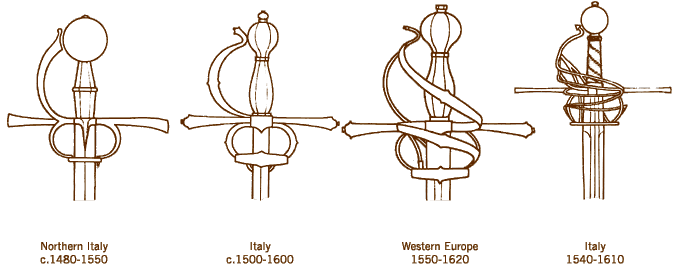Variety and Evolution of the Hilt
Hilts come in a wide variety of forms, depending on the particular use of the weapon in question and on the fighting techniques being practiced at any given time. The hilt first made its appearance on bronze swords dating back to the period of transition to the Iron Age, when the blade of the short was sword joined to the grip by rivets; but it did not become a true protective element until the period of the "barbarian" migrations. A clearly defined protective hilt started to appear in Viking swords, although the cross guard did not protrude far from the grip. In the Carolingian sword, however, the cross guard became more pronounced, and after the 10th century it started to become longer, often flattening out at the ends and also curving forward toward the blade.

The earliest blades, cast or forged in bronze and iron, were made for fighting techniques based entirely on the thrust; in this period the hilt was no more than embryonic. Before long, and not least because of great progress in metallurgy and constructional techniques, swords were designed for delivering cutting blows, and it was soon clearly necessary to extend the quillons, or cross guard, to ward off blows from the enemy's blade. During the Middle Ages the quillons became gradually longer, and the whole format of the sword was modified; it now sported a fairly broad blade, grooved at the center and often rounded at the tip. Throughout the 14th century the various modifications only applied to the length of the quillons; these varied from country to country as a result of local preferences, but they invariably remained perpendicular to the blade, were fairly round or four-sided in section, and often flattened out at the ends. They were frequently curved toward the blade, but sometimes toward the handle, although this was rare, being quite unsuitable for the hand when a wide motion was required to deliver a powerful cutting blow. After the 15th century the hilt became progressively smaller in size, not less because of the wide use of new protective elements; the arms of the hilt and various additional parts (loops, rings, bars, and so on).

In weapons with a single cutting edge, the most suitable shape for the quillons was that of an S, in the plane of the blade; long, straight quillons would only be able to block the cutting blow tihtou at the same time offering an effective protection to the hand. In daggers the quillons were either straight and short, or curved toward the blade—especially in parrying weapons. The two-handed swords of the 15th and 16th centuries had larger quillons and grips; in fact everything in these weapons was on a large scale, from the blade, which was often more than 50" long, to the grip, which had to be long enough to accommodate both hands, to the heavy pommel, which had to act as a counterweight to the long blade. The quillons in these fighting swords came in various shapes, and were even more ornate in those used for ceremonial purposes.

With the 17th century the quillons once more became straight, owing to new fencing techniques that introduced various thrusting blows. The sword itself had been considerably modified, its blade having become narrow and long, with a fairly flattish rhomboid section, often grooved, at least in the rear section (forte). The quillons of the Spanish-type sword protruded far from the shell guard or cup guard, and were very efficient at parrying. In the smallsword and dress sword, the quillons were short and lobed at the tips, and barely protruded from the shell guard.

In the meantime swords were becoming more and more specialized, being made in different ways, depending on whether they were to be used on foot or on horseback, either solely as weapons or as beating implements on the hunt; then there were the various ceremonial swords, which must be looked at separately. On the whole, swords for use on horseback were bulkier and heavier, whereas those for use on foot had a narrower blade and a lighter hilt; swords used by infantrymen were altogether more simple and functional.

The ceremonial swords were quite different; here, the construction involved not only the armorer but also the artist. The ceremonial function was paramount, although, constructionally speaking, these weapons often remained quite valid fighting pieces and generally reflected all the features of weapons in current use. These clearly defined forms were retained even when the original model was already out of date or obsolete. Typical examples are the papal sword, which for a long time retained abandoned forms.

An important step in the evolution of the hilt was the addition of the knuckle guard in the 15th century. This protection was essential in any fight with cutting swords and permitted abandoning the bulky steel gauntlet in favor of a lighter and more comfortable leather glove. After the mid-15th century the knuckle guard was almost invariably present in the hilt of swords. A further step toward almost complete protection of the hand came from the adoption of the "two-bar" and later the "tree-bar" knuckle guard; the main guard bow split into three bars which joined up with the quillons or arms of the hilt. Also the side rings or loops increased in number, to as many as eight or nine in some hilt types. With the introduction of the shell guard, which gradually became larger until, in the mid 17th century Spanish sword, it formed a complete "cup," the hand was completely protected. However, for use in battle, as well as for everyday wear, the sword now returned to simpler forms, relegated as it was to secondary functions, due to the effectiveness of firearms. The edged weapon still remained part of military equipment, but they grew les and less important, finally becoming more of a symbol, which is their role today.
|
|

